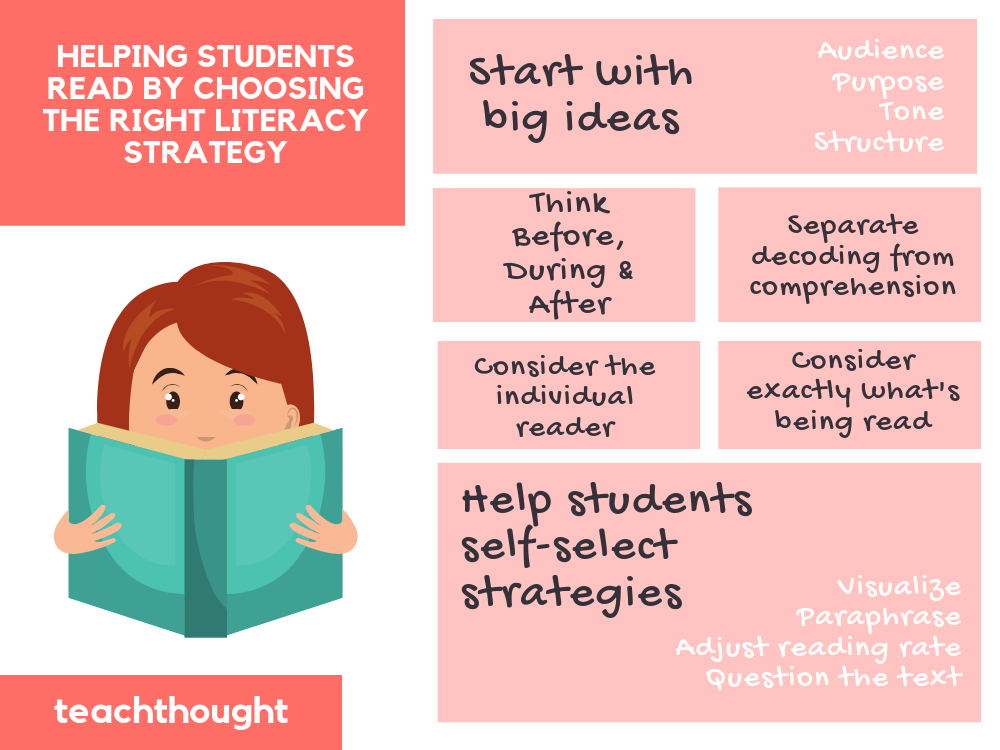
How To Help Students Read By Choosing The Right Literacy Strategy
by Terry Heick
As the title states, this post is about helping students learn to read by choosing (or helping them choose) a literacy strategy that works for them–that day, reading that text, for that specific purpose.
So, this post is not about the literacy strategies themselves but rather how to select from those kinds of strategies to support students as they make sense of a range of texts, writing styles, and media formats. If it’s not obvious enough, reading involves higher-level thinking.
There’s a lot to consider.
1. Start with the big ideas of written communication
Who is saying what to whom? That is, ‘Who (author) is saying what (theme/main idea, etc.) to whom (audience)?’
This can get more complicated–who is saying what to whom and how (tone) using what written and explicit (e.g., literary devices) and implicit (e.g., narrative perspectives) tools to convey that message. However you approach it, the broadest literacy strategy there is to understanding who’ is saying ‘what.’
2. Separate decoding from comprehension
Though these must work together in real-time during the ‘sense making’ (reading) process, choosing specific reading strategies that work for students can be framed by the ‘Before/During/After’ concept.
Think Before, During, and After
Thinking chronologically–that is, separate reading strategies into three basic categories: Before Reading, During Reading, and After Reading.
This likely deserves a separate post. Just know that as a time-bound process, reading occurs in the present but sense-making begins before and extends after the reader. This means unique literacy strategies come into play accordingly, so the ‘when’ factor matters when choosing the ‘right’ literacy strategy.
Consider the individual reader
In short, this means to consider ‘the reader’ as opposed to what you hope they take away from the reading or even the text itself.
This could mean to consider the ‘reading level’ of the student, their general motivation to read, their specific motivation to read a specific text for a specific assignment, and so on.
The point is, personalize the literacy and sense-making ‘process’ as much as possible for the reader. For some readers, the best ‘literacy strategy’ could be to simply leave them alone, while others may benefit from a specific note-taking startegy, and another may find adjusting reading rate and breaking the reading up into short segments more useful.
Figure out what works for them–and then help them figure out what works for themselves when you’re not around.
Consider exactly what’s being read
This is part of the ‘consider the reader’ approach. Just as making sense of a documentary is different than making sense of a YouTube video or motion picture, making sense of an essay, novel, poem, and play all use different modes and syntax and patterns to communicate ideas–which means different ‘things’ help when making sense of each.
Help students self-select among a given set of literacy strategies
Ultimately, your job in helping students understand what they read is to provide them with tools personalized for their reading strengths and ‘areas for growth’ (personally, I have actual weaknesses as a reader but I know it’s not in fashion to say it that way, nor is it likely helpful for them to think of them as ‘weaknesses’ as such a young age). Then, once equipped, they need to have the skills and habit/tendency to self-select from those literacy strategies to make sense of a range of texts.
Put another way, they need to have a range of literacy strategies they know how to use, then (more crucially) they need to develop the reflect to actually reach for and use those strategies on the fly as they read inside and outside of your classroom.